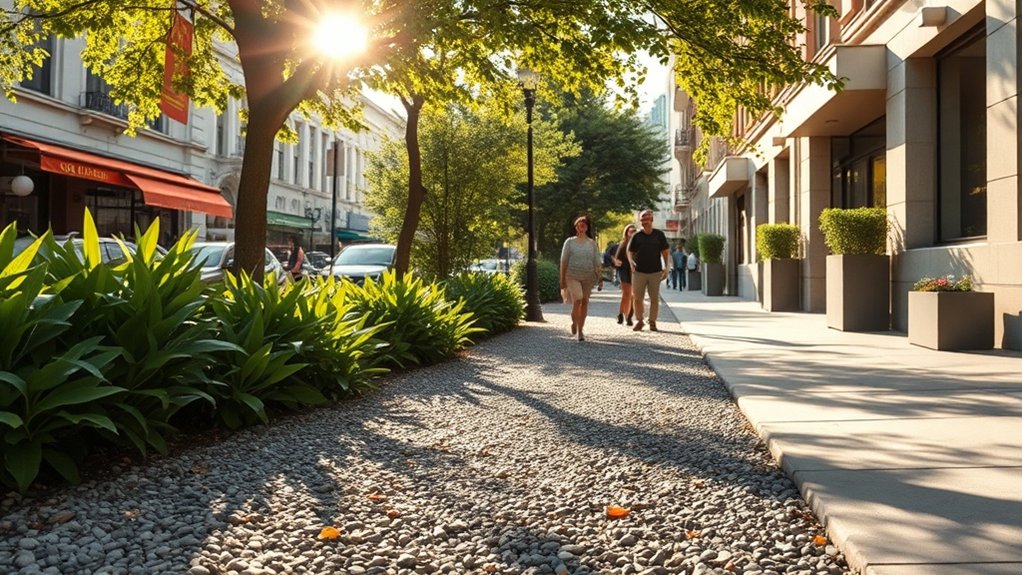Resin-bound gravel helps tackle urban heat islands by improving surface permeability, which allows for effective water drainage and evaporation. This process cools the surface, reducing the heat retention typical of hard urban structures. Made from natural stones, resin-bound gravel also enhances thermal properties, resulting in a higher albedo that reflects sunlight. As a result, this innovative paving solution lowers surface temperatures, promotes sustainability, and encourages urban green spaces. Explore its diverse applications and benefits for your community.
Key Takeaways
- The high permeability of resin-bound gravel enables effective water drainage and evaporation, helping to lower surface temperatures in urban areas.
- Its reflective qualities can reduce heat absorption by over 10 °C, which helps combat the urban heat island effect.
- The moisture retention in resin-bound gravel enhances evaporative cooling, contributing to cooler microclimates in cities.
- This durable surface requires minimal maintenance, ensuring consistent effectiveness in stormwater management and heat reduction.
- Incorporating resin-bound gravel into urban designs promotes biodiversity and improves access to green spaces, fostering social equity.
Understanding Urban Heat Islands
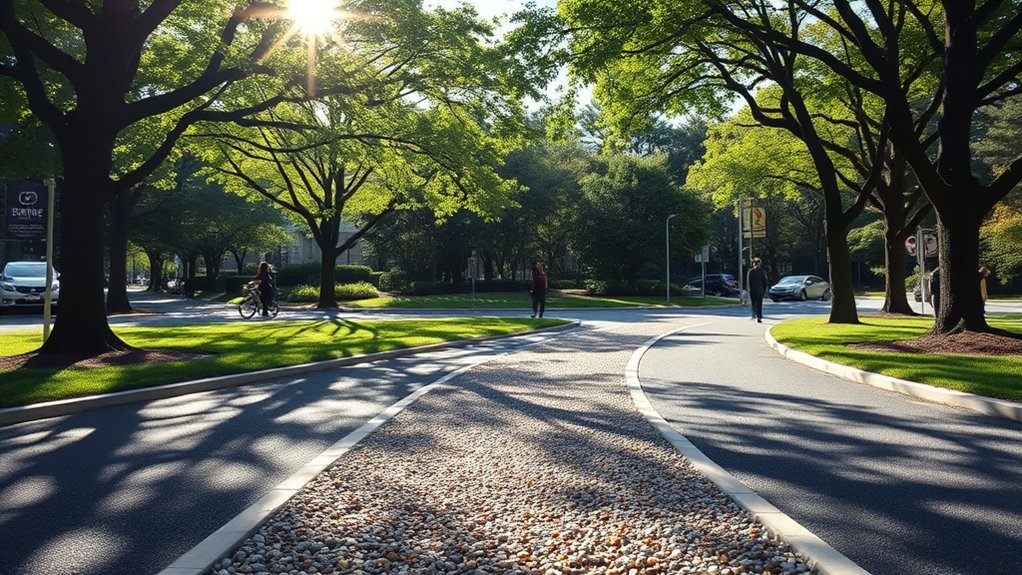
As urban areas continue to grow, understanding urban heat islands (UHIs) is becoming increasingly important. These heat islands form due to temperature differences between cities and nearby rural areas, mainly caused by hard surfaces like concrete and asphalt that absorb and retain heat. The absence of greenery limits natural cooling, while building designs can trap heat and restrict airflow. Within cities, there are microclimate variations that lead to localized temperature differences, which can heighten health risks, particularly for vulnerable groups. To combat these issues, urban planning must implement effective cooling strategies that promote social equity by ensuring everyone has access to green spaces. Each 1°C increase in temperature raises energy demand by 0.5% to 5%, highlighting the urgency of addressing UHI effects. Ultimately, improving climate resilience requires a comprehensive approach to mitigate UHI effects, fostering healthier urban environments for all residents. Implementing permeable paving solutions can also help alleviate UHI effects by allowing rainwater absorption and reducing surface temperatures.
The Role of Permeability in Urban Surfaces
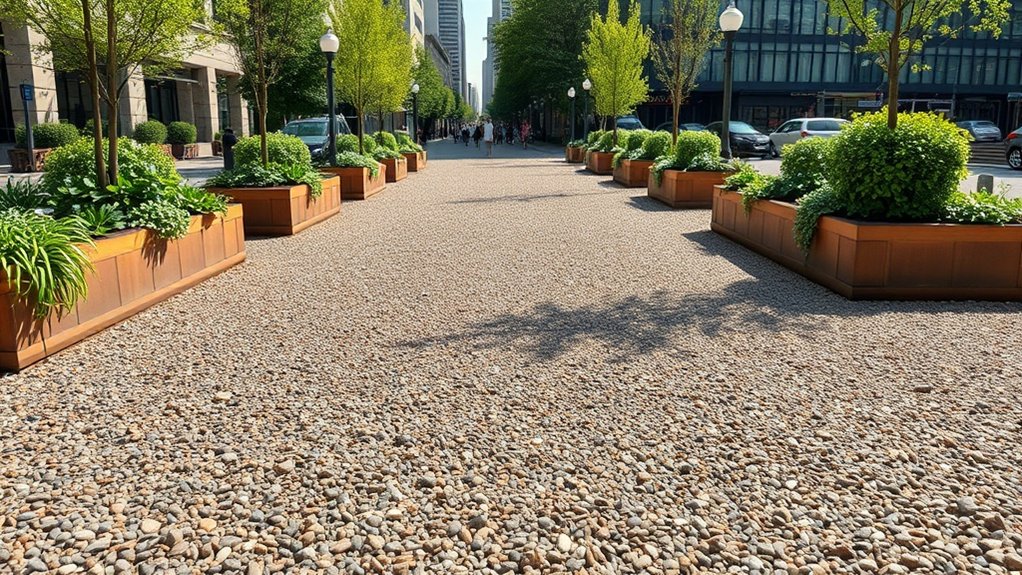
Permeability in urban surfaces is crucial for reducing the impacts of urban heat islands by promoting natural cooling methods. By allowing water drainage and evaporation, permeable pavements can lower surface temperatures and boost urban ecology. Here’s a brief overview of the benefits of permeability:
| Benefit | Description | Impact on Urban Ecology |
|---|---|---|
| Natural Cooling | Evaporation cools pavement temperatures | Lessens urban heat retention |
| Moisture Retention | Keeps soil cool for plant growth | Supports biodiversity |
| Stormwater Management | Reduces runoff and thermal pollution | Protects local waterways |
| Lower Heat Absorption | Porous surfaces retain less heat | Reduces heat-related illnesses |
| Enhanced Albedo | Reflective surfaces bounce back solar radiation | Lowers local air temperatures |
These aspects highlight how permeability fosters sustainable urban living. Additionally, increased heat in urban areas can lead to heightened energy demand and health risks, making permeability an essential feature for modern urban infrastructure. The ability of resin-bound surfaces to achieve up to 95% permeability further enhances their role in proactive urban water management initiatives.
Composition of Resin-Bound Gravel
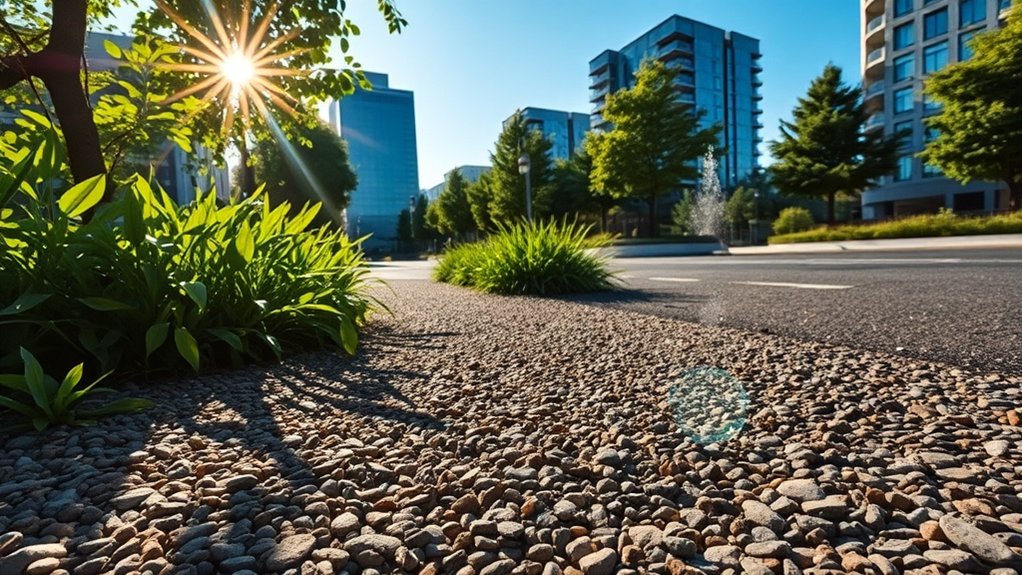
Understanding the composition of resin-bound gravel is crucial for its use in urban areas, especially for reducing heat islands. This material generally consists of a two-part polyurethane resin binder mixed with selected aggregates.
These aggregates, typically sized between 1–3mm and 2–5mm, include natural stones such as quartz, marble, and granite, each contributing to the material’s strength and appearance. The resin binder offers durability and flexibility, ensuring the surface withstands various conditions. The use of washed and kiln-dried aggregates enhances the overall finish while improving the bond with the resin, which is essential for longevity.
Properly graded aggregates improve permeability and lifespan, with a standard mix comprising about 75% coarse and 25% finer aggregates. This careful composition not only maintains structural integrity but also facilitates effective drainage, which is essential in urban settings. Additionally, these aggregates are carefully washed and kiln-dried to ensure a high-quality finished product that enhances the performance of resin-bound surfaces.
Thermal Properties and Their Impact
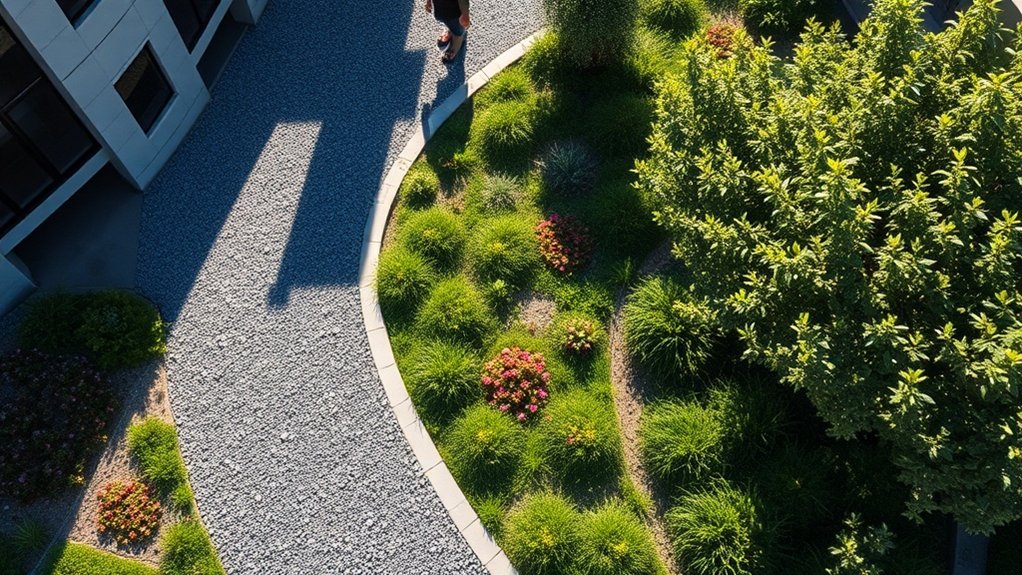
Traditional pavements often worsen the urban heat island effect, but resin-bound gravel presents a solution with its impressive thermal properties.
This surfacing material has better thermal conductivity and a higher albedo, which helps it reflect more solar radiation. As a result, it can reduce temperatures by more than 10 °C.
The addition of thermal fillers enhances both heat dissipation and reflectivity, promoting effective cooling. Furthermore, resin-bound gravel has high thermal emittance, allowing it to release heat quickly at night and avoid retaining warmth.
Its permeability also supports thermal regulation by enabling evaporative cooling, which helps keep subsurface temperatures down.
Environmental Benefits of Permeable Surfaces
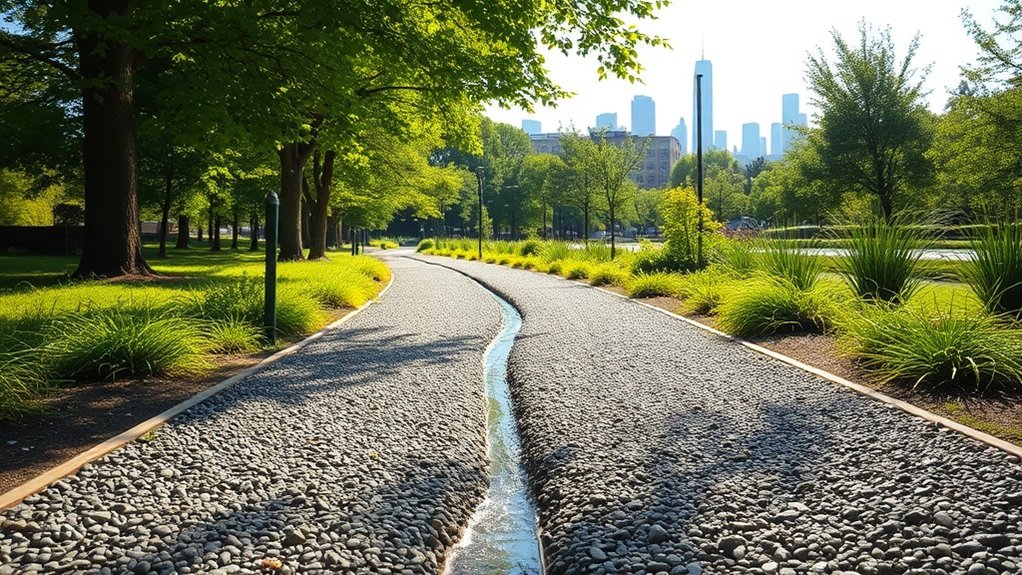
Resin-bound gravel’s thermal properties help reduce the urban heat island effect and provide significant environmental benefits through permeable surfaces. These surfaces support sustainable design by improving stormwater management and enhancing ecological outcomes.
| Benefit | Description |
|---|---|
| Reduced Stormwater Runoff | Lightens the load on urban drainage systems. |
| Pollutant Removal | Filters out pollutants, improving water quality. |
| Increased Groundwater Recharge | Aids in replenishing aquifers and groundwater. |
| Improved Flood Control | Helps to prevent flooding and erosion. |
| Eco-Friendly Materials | Lowers carbon footprints in construction. |
Durability and Maintenance Considerations
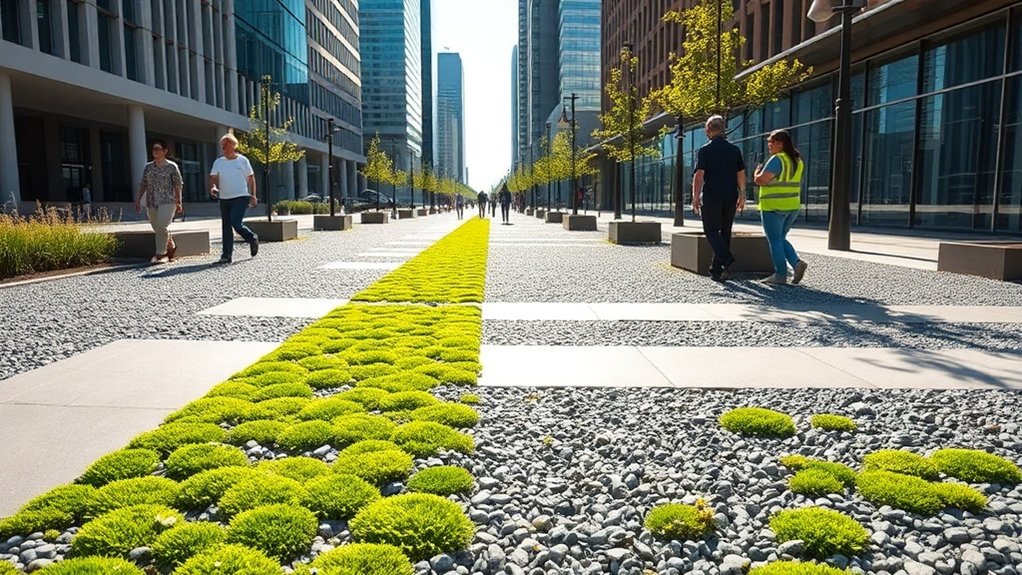
Durability and maintenance are crucial when it comes to resin-bound gravel surfaces, as they significantly influence the lifespan and effectiveness of these installations. Key durability factors include a strong resin matrix that withstands cracking and weather-related damage, along with weed resistance that helps maintain surface integrity.
To ensure optimal performance, it’s important to adopt straightforward maintenance practices. Regular sweeping and pressure washing—ideally once or twice a year—can prevent debris build-up and keep drainage functioning properly.
It’s also essential to promptly clean up spills and stains to avoid potential damage. Additionally, be cautious with heavy loads and sharp impacts to protect the surface.
Urban Planning and Sustainability Goals
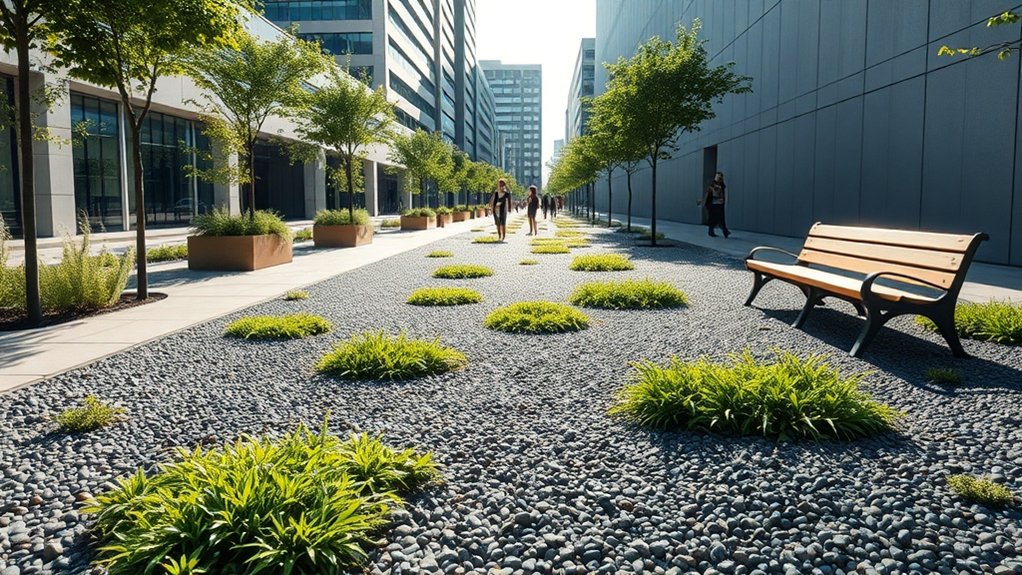
As urban areas continue to grow, tackling the Urban Heat Island (UHI) effect is crucial for effective urban planning and sustainability.
Incorporating permeable materials, such as resin-bound gravel, into city design enhances resilience and climate adaptation. These surfaces allow rainwater to infiltrate, which helps lower surface temperatures and reduce energy use. This not only alleviates UHI effects but also supports sustainable drainage systems, vital for managing stormwater.
Comparative Advantages Over Traditional Pavements
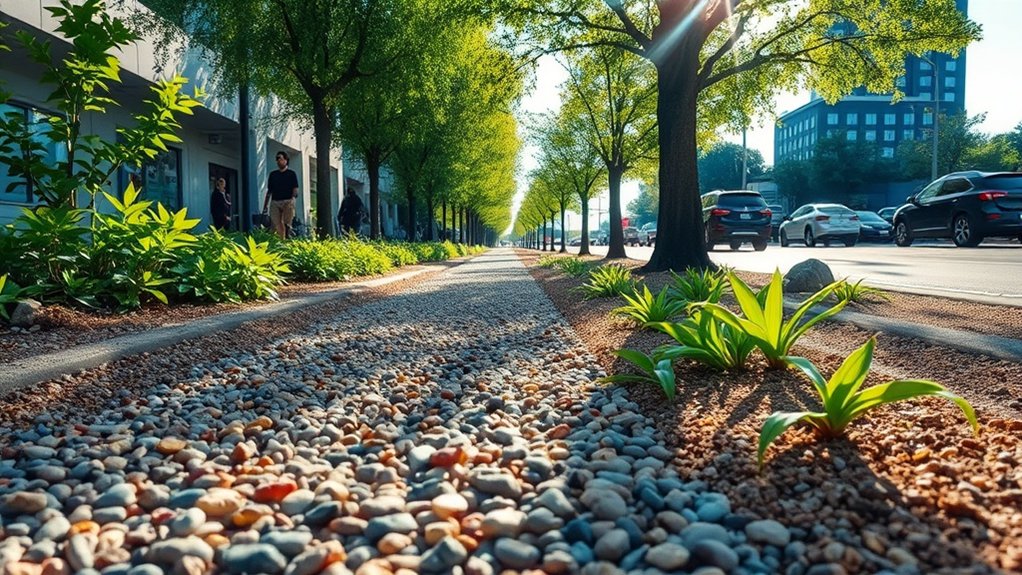
In the pursuit of sustainable urban planning, the benefits of resin-bound gravel compared to traditional pavements are clear. The permeability of resin-bound gravel allows water to drain directly into the ground, reducing surface runoff and lowering the risk of flooding. This stands in stark contrast to traditional materials like concrete and asphalt, which often require expensive drainage systems.
Moreover, resin-bound surfaces generally have lower long-term maintenance costs due to their minimal upkeep requirements. In comparison, traditional options tend to lead to higher ongoing expenses.
While the initial investment in resin-bound gravel might be greater, its durability and reduced maintenance make it a more cost-effective choice over time. Ultimately, resin-bound gravel not only enhances water management but also contributes positively to urban environments.
Case Studies of Successful Implementation
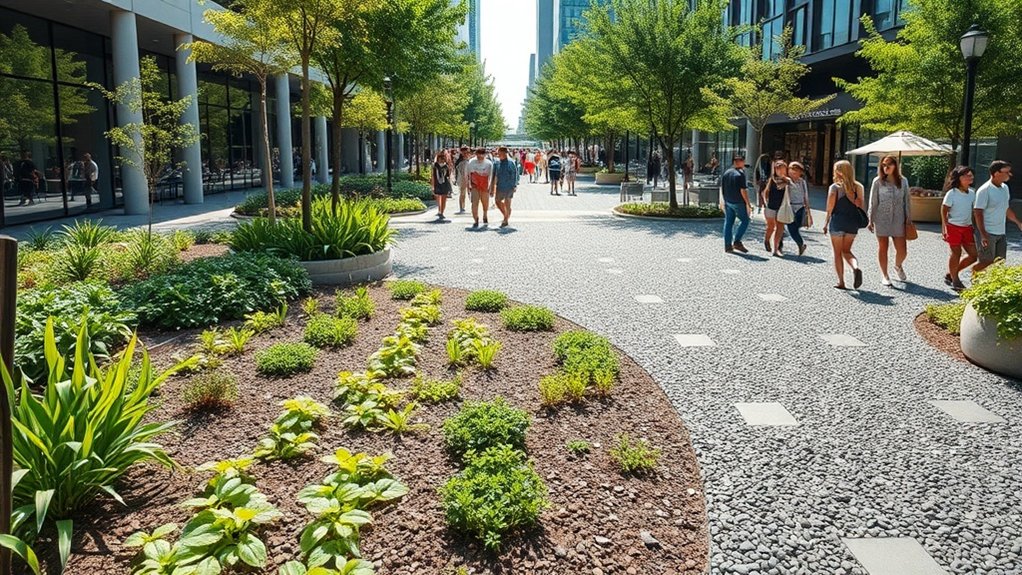
Several cities have successfully adopted resin-bound gravel in urban parks, residential areas, and commercial properties.
These case studies demonstrate how this innovative material not only improves visual appeal but also helps reduce urban heat.
Urban Park Implementation
Urban parks are vital for reducing the urban heat island effect, but effective implementation needs to be tailored to each city’s specific needs.
For example, Singapore’s LUSH initiative incorporates greenery into high-rise buildings, improving cooling and airflow.
In London, large parks like Hyde Park act as essential cooling zones, supported by community-led tree-planting efforts.
Chicago focuses on deploying green infrastructure in heat-vulnerable, low-income areas.
Hannover’s urban parks, known as cool islands, highlight the necessity of tree cover.
These examples illustrate the importance of thoughtful design and community involvement to enhance the cooling effects of urban parks in various urban environments.
Residential Development Examples
As urban areas grapple with rising temperatures and environmental issues, innovative residential developments are increasingly opting for resin-bound gravel solutions to boost sustainability and comfort.
These projects replace hard, impermeable surfaces with permeable resin-bound driveways and pathways. The lighter aggregates reflect sunlight and allow rainwater to seep through, significantly lowering surface temperatures.
Homeowners benefit from low maintenance while enhancing community aesthetics with a range of colours and patterns. Moreover, combining resin-bound surfaces with greenery helps support tree health, which further alleviates heat.
Case studies show that these installations provide effective cooling benefits, improve outdoor comfort, and reduce energy consumption for nearby homes, demonstrating a smart blend of practicality and style in modern residential settings.
Commercial Space Applications
Recent case studies demonstrate the effective use of resin-bound gravel in commercial spaces to tackle urban heat islands.
In Fresno, cool pavements made from porous materials recorded surface temperatures 1–2 °C lower than traditional lawns, showcasing their heat-mitigating properties.
Similarly, Athens has seen significant reductions in surface temperatures in commercial areas through permeable cool pavements.
U.S. cities report enhanced thermal comfort in busy parking lots, which have helped lower peak air temperatures.
Developments in Boston highlight the benefits of resin-bound paving, aligning with regulatory standards and promoting urban resilience.
The high permeability of resin-bound gravel allows for water infiltration, enhancing cooling through evaporation and contributing to appealing commercial aesthetics.
These examples illustrate how innovative pavement solutions can effectively reduce urban heat islands and support environmental sustainability.
Frequently Asked Questions
How Does Resin-Bound Gravel Compare to Other Permeable Materials?
Resin-bound gravel is highly durable and low-maintenance compared to other permeable materials. Its straightforward installation and excellent permeability make it a practical option for driveways and paths. However, it may require more frequent cleaning to avoid clogging. Overall, it’s a solid choice for those looking for an effective and attractive surface.
What Colors Are Available for Resin-Bound Gravel Surfaces?
Resin-bound gravel surfaces come in a wide range of colours, from natural earthy shades to contemporary greys. This variety allows you to create a unique look that complements your surroundings. For instance, a warm terracotta can give a rustic feel, while a sleek charcoal grey adds a modern touch.
Can Resin-Bound Gravel Be Installed Over Existing Pavement?
Yes, you can install resin-bound gravel over existing pavement, as long as the surface is clean, structurally sound, and free from cracks. For instance, if you have an old tarmac driveway, ensure it’s in good condition before proceeding. Address any imperfections to ensure a durable and effective overlay.
Is Resin-Bound Gravel Suitable for High-Traffic Areas?
Yes, resin-bound gravel is highly suitable for high-traffic areas. Its durability means it can endure heavy footfall, while its slip-resistant surface enhances safety. Plus, it requires very little maintenance, making it a practical choice for busy spaces like walkways, driveways, and commercial premises. Overall, it offers long-lasting performance with minimal hassle.
How Does UV Exposure Affect Resin-Bound Gravel’s Lifespan?
UV exposure can significantly reduce the lifespan of resin-bound gravel, much like how sunlight fades a cherished photograph. To extend its durability, opt for UV-stable products and implement protective measures. This helps prevent damage, keeping both its appearance and structural integrity intact over time.
Conclusion
Incorporating resin-bound gravel into urban design improves permeability and helps combat the urban heat island effect. This innovative material meets modern environmental goals by reducing heat retention and cooling urban spaces. For example, using resin-bound gravel in parks and driveways allows rainwater to soak through, reducing surface temperatures. Prioritising permeability in city planning can lead to cooler, more resilient environments. Adopting resin-bound gravel is a practical step towards sustainable urban living.
